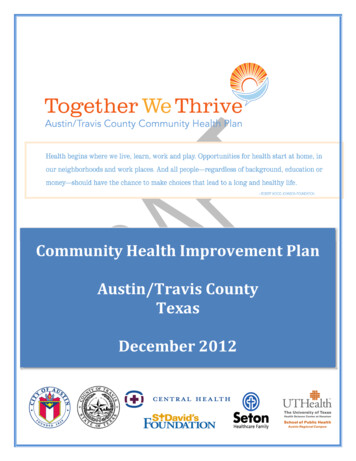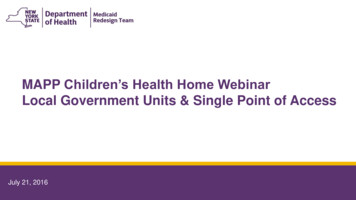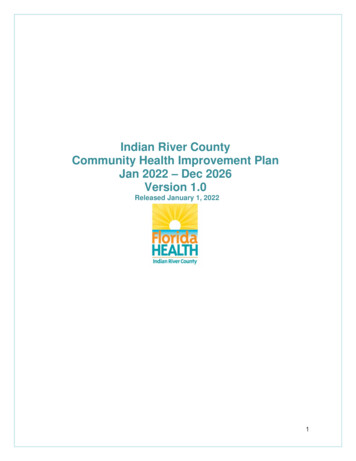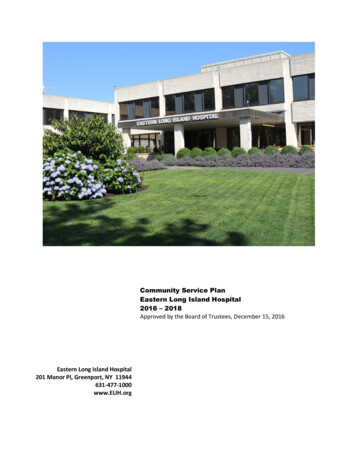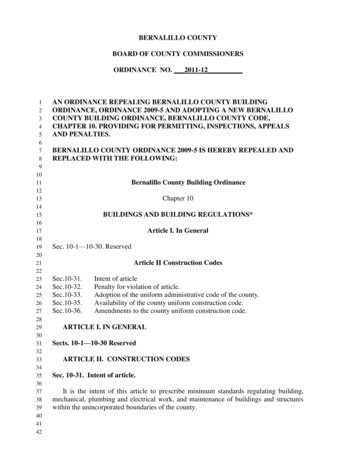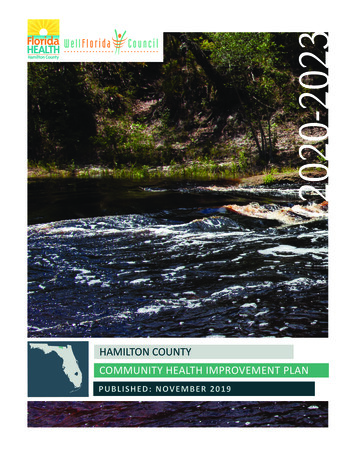
Transcription
2020-2023HAMILTON COUNTYCOMMUNITY HEALTH IMPROVEMENT PLANP UBLISHED : NOV EM BER 2019
Record of ChangesDate ofRevisionRevision DescriptionSection/ComponentRevision Completed By
This page is intentionally left blank.
ContentsExecutive Summary of the Hamilton County Community Health Improvement Plan 2020-2023 1Hamilton County Community Health Improvement Plan Strategic Priorities and Goals 1Overview of Community Health Improvement Planning 3Community Health Needs Assessment and Health Improvement Planning 3The Role of Social Determinants of Health and Health Equity in Community Health Improvement Planning5Hamilton County Community Health Improvement Plan (CHIP) Process 7Methodology 7MAPP Phase 1: Organizing for Success and Partnership Development 7MAPP Phase 2: Visioning 7MAPP Phase 3: Four MAPP Assessments 8MAPP Phase 4: Identifying Strategic Issues 11MAPP Phase 5: Formulate Goals and Strategies 13MAPP Phase 6: Action Cycle 13Hamilton County Community Health Assessment and Health Improvement Timeline 13Hamilton County CHIP Goals, Strategies and Objectives 15Hamilton County CHIP Alignment with State and National Priorities 19Appendix 23Hamilton County Healthcare Strategic Planning Committee Members 24Hamilton County Visioning Results 25Hamilton County CHIP Implementation Action Plan Template 27
Executive Summary of the Hamilton County CommunityHealth Improvement Plan 2020-2023HAMILTON COUNTY COMMUNITY HEALTH IMPROVEMENT PLAN STRATEGICPRIORITIES AND GOALSStrategic Priority: Mental Health and Substance Abuse Goal I: Decrease alcohol abuse Goal II: Increase community resources for mental health servicesStrategic Priority: Healthy Behaviors Goal I: Reduce modifiable risk factors for chronic diseases and conditions Goal II: Reduce tobacco use Goal III: Reduce STD ratesStrategic Priority: Healthcare Resource Use Goal I: Increase appropriate use of healthcare services Goal II: Address barriers to healthcare servicesStrategic Priority: Maternal and Infant Health Goal I: Increase healthy birth outcomes Goal II: Provide Hamilton County infants and children an early, healthy startIn September 2018, the Florida Department of Health in Hamilton County began a new community healthassessment and health improvement planning cycle. As has been the practice in Hamilton County, theMobilizing for Action through Planning and Partnerships (MAPP) framework was employed to assure acomprehensive community health assessment would inform the development of the community healthimprovement plan. Guided by community partners in the Hamilton County Healthcare Strategic PlanningCommittee, the MAPP process yielded a wealth of data (see companion documents, 2019 Columbia andHamilton Community Health Assessment Technical Appendix and 2019 Hamilton County Community HealthAssessment) that was used to identify strategic priorities for the coming four years of 2020-2023. Thestrategic priorities include: Mental Health and Substance Abuse: Concerns about mental health and substance abusesurfaced in all four MAPP assessments. Both the community and healthcare providers identifiedmental health and substance abuse as the most important health issues. Further, substance andPAGE 1
alcohol abuse were among the leading behaviors with the greatest negative on health. Secondarydata showed that in 2017 Hamilton County residents visited emergency rooms for mental healthreasons at rates higher than for the state as a whole. The percentage of Hamilton County adults whoreported that poor mental or physical health interfered with activities of daily living was almosttwice that of the state rate.Healthy Behaviors: Much of the chronic disease burden can be attributed to behaviors related toalcohol and tobacco use, lack of physical activity and poor nutrition. Hamilton County adultsreported higher than state rates of Diabetes, Coronary Heart Disease, Stroke, Chronic ObstructivePulmonary Disease and Asthma as well as higher percentages of overweight and obesity, physicalinactivity, and tobacco use. Unsafe sex practices contribute to problematic STD rates in HamiltonCounty.Healthcare Resource Use: Although access to health care does not necessarily prevent illness,early intervention and long-term management resources can help to maintain quality of life andminimize premature death and disability. Assessment findings point to many barriers to healthcareresource access for Hamilton County residents. Access to healthcare was among the most importanthealth issue concerns among survey respondents. Rates of emergency room use by HamiltonCounty residents for avoidable causes continues to rise and the capacity to link people to neededservices is assessed as low, pointing to gaps in care coordination and health literacy.Maternal and Infant Health: Infant mortality is an important gauge of population health. Ingeneral infant mortality rates can fluctuate widely because of small numbers. However, as recentlyas 2016, Hamilton County’s infant mortality rate was twice that of the state rate. Relatedly,Hamilton County has higher than state rates of births to mothers who received late or no prenatalcare. Concerns for the health and safety of Hamilton County children emerged throughout theassessment phases. Among the threats to child health and well-being were homelessness, foodinsecurity, and exposure to trauma.PAGE 2
Overview of Community Health Improvement PlanningCOMMUNITY HEALTH NEEDS ASSESSMENT AND HEALTH IMPROVEMENT PLANNINGIn the Institute of Medicine’s (IOM) 1997 publication Improving Health in the Community, the communityhealth improvement planning process was described as the required framework within which a communitytakes a comprehensive approach to improving health. That framework includes assessing the community’shealth status and needs, determining health resources and gaps, identifying health priorities, anddeveloping and implementing strategies for action. Notably, in this comprehensive approach there are twocycles; that is, an assessment or problem identification and prioritization cycle followed by animplementation cycle. By 2000 the National Association of County and City Health Officials (NACCHO) inconjunction with the Centers for Disease Control and Prevention’s (CDC) Public Health Practice Office haddeveloped Mobilizing for Action through Planning and Partnerships (MAPP) as a strategic approach tocommunity health improvement.FIGURE 1: COMMUNITY HEALTH IMPROVEMENT PLANNING FRAMEWORK, IOM, 1997.Source: J.S. Durch, L.A. Bailey, and M.A. Stoto, eds. (1997) Improving Health in the Community, Washington, DC: NationalAcademy Press. Retrieved: August 8, 2019, nPAGE 3
NACCHO and the CDC’s vision for implementing MAPP remains today as "Communities achieving improvedhealth and quality of life by mobilizing partnerships and taking strategic action."At the heart of the MAPP process are the following core MAPP assessments: Community Health Status AssessmentCommunity Themes and Strengths AssessmentForces of Change AssessmentLocal Public Health System AssessmentThe findings from four MAPP assessments inform the detection of common themes and issues in order toidentify and prioritize the key community health needs. Prioritized strategic community health issues aredocumented and addressed in the MAPP action cycle phase to complete the comprehensive healthimprovement planning cycle.FIGURE 2: MOBILIZING FOR PLANNING THROUGH PLANNING AND PARTNERSHIPS (MAPP)Source: National Association of County and City Health Officials (N.D.). Community Health Assessment and ImprovementPlanning. Retrieved August 8, 2019, -assessmentThe Public Health Accreditation Board (PHAB), the voluntary accrediting body for public health agencies inthe United States, deems community health, community health assessment and health improvementplanning as foundational functions and core to the mission of public health. Community health assessmentis defined in the PHAB Standards and Measures as a tool “to learn about the community: the health of thepopulation, contributing factors to higher health risks or poorer health outcomes of identified populations,and community resources available to improve the health status.” The community health improvement planis described as a “long-term, systematic effort to address public health problems on the basis of the resultsof community health assessment activities and the community health improvement process.” Further, thecommunity health improvement process “involves an ongoing collaborative, community-wide effort toPAGE 4
identify, analyze and address health problems; assess applicable data; develop measurable health objectivesand indicators; inventory community assets and resources; identify community perceptions; develop andimplement coordinated strategies; identify accountable entities; and cultivate community ownership of theprocess.” Public Health Accreditation Board (December 2013). PHAB Standards and Measures. RetrievedAugust 8, 2019, ion-1.5-Board-adopted-FINAL-0124-2014.docx.pdfTHE ROLE OF SOCIAL DETERMINANTS OF HEALTH AND HEALTH EQUITY INCOMMUNITY HEALTH IMPROVEMENT PLANNINGFIGURE 3: SOCIAL DETERMINANTS OF HEALTH (SDOH).Neighborhoodand BuiltEnvironmentEconomicStabilityHealth andHealth CareSDOHSocial andCommunityContextEducationSource: Healthy People 2020: Social Determinants of Health,” Office of Disease Prevention and Health Promotion,Centers for Disease Control and Prevention. Retrieved August 8, 2019, s/topic/social-determinants-of-healthAccording to the World Health Organization and depicted above by the Centers for Disease Control andPrevention (CDC), the social determinants of health (SDOH) include the “conditions in the environments inwhich people are born, live, learn, work, play and age that shape and affect a wide range of health,functioning, and quality of life outcomes and risks”. (About Social Determinants of Health,” World HealthPAGE 5
Organization, accessed August 8, 2019 http://www.who.int/social determinants/sdh definition/en/). TheSDOH include factors such as socioeconomic status, education, neighborhood and physical environment,employment and social networks as well as access to health care. Addressing social determinants of healthis important for improving health and reducing health disparities. Research suggests that health behaviorssuch as smoking and diet and exercise, are the most important determinants of premature death. There isgrowing recognition that social and economic factors shape individuals’ ability to engage in healthybehaviors. Evidence shows that stress negatively affects health across the lifespan and that environmentalfactors may have multi-generational impacts. Addressing social determinants of health is not only importantfor improving overall health, but also for reducing health disparities that are often rooted in social andeconomic disadvantages.The five tier health impact pyramid depicts the potential impacts of different types of public healthinterventions. Efforts that address the SDOH are at the base of the pyramid, indicating their higher potentialfor positive impact. Interventions at the pyramid base tend to be effective because of their broad societalreach. CHIP interventions are targeted at all levels to attain the best and most sustainable health benefits.FIGURE 4: HEALTH IMPACT PYRAMID.Source: Frieden, T.R. (2010). A framework for public health action: The health impact pyramid. American Journal ofPublic Health, 100(4):590-595. Retrieved August 8, 2019, 40/PAGE 6
Hamilton County Community Health Improvement Plan(CHIP) ProcessMETHODOLOGYDevelopment of the Hamilton County CHIP is a continuation of the community health assessment processusing the MAPP model. Community health assessment work began in September 2018 and wrapped up inMarch 2019. The four MAPP phases of Hamilton County’s community health assessment process are brieflydescribed below. Soon after completing the assessment, Hamilton County partners launched into planningfor the CHIP process and completing the final two MAPP phases.MAPP PHASE 1: ORGANIZING FOR SUCCESS AND PARTNERSHIP DEVELOPMENTTo assure a successful community health assessment and health improvement planning process, the FloridaDepartment of Health in Hamilton County engaged partners to plan a process that built upon existingrelationships, used resources wisely, and demonstrated a commitment to making positive, collective impacton health and quality of life in Hamilton County. The Hamilton County Community Health AssessmentSteering Committee members and their affiliations can be found in the 2019 Hamilton County CommunityHealth Assessment report.MAPP PHASE 2: VISIONINGAt their first meeting in September 2018, the Hamilton County Community Health Assessment SteeringCommittee members defined health and the characteristics of a healthy Hamilton County through avisioning exercise. Among the categories of attributes were an equitable standard of living, accessiblehealthcare services, systems and infrastructure that support children and youth, conditions that encouragehealthy behaviors and decisions, and supportive leadership. Visioning results are included in the Appendix.The word cloud below depicts terms that were frequently used to define health in Hamilton County.FIGURE 5: VISIONING WORD CLOUD, HAMILTON COUNTY, 2019Source: Hamilton County visioning exercise results, September 19, 2018, prepared using WordItOut by Enideo byWellFlorida Council, 2019PAGE 7
MAPP PHASE 3: FOUR MAPP ASSESSMENTSEach of the four MAPP assessments gathered data to provide a comprehensive picture of health status,health behaviors, and health resources and capacities in Hamilton County. Key findings and highlights fromeach of the assessments are summarized below.Local Public Health System Assessment:The capacity of the Hamilton County local public health system to provide the ten essential public healthservices was assessed using the Centers for Disease Control and Prevention’s (CDC) National Public HealthPerformance Standard Program instrument. Over the course of two meetings, Hamilton County communitypartners and stakeholders discussed and scored various competencies. Partners also identified strengths tobuild on and areas for improvement. Summary scores from the local public health system assessment are asfollows: One (1) or 10% of essential services was scored at the optimal activity includingo Essential Service 2: Diagnose and Investigate Health Problems and Health HazardsSeven (7) or 70% of essential services were scored at the significant activity level includingo Essential Service 1: Monitor Health Status to Identify Community Health Problemso Essential Service 3: Inform, Educate and Empower People about Health Issueso Essential Service 4: Mobilize Community Partnerships to Identify and Solve HealthProblemso Essential Service 5: Develop Policies and Plans that Support Individual and CommunityHealth Effortso Essential Service 6: Enforce Laws and Regulations that Protect Health and Ensure Safetyo Essential Service 8: Assure a Competent Public and Personal Healthcare Workforceo Essential Service 9: Evaluate Effective, Accessibility and Quality of Personal and PopulationHealth ServicesOne (1) or 10% of essential services was scored at the moderate activity level includingo Essential Service 7: Link People to Needed Personal Health Services and Assure theProvision of Health Care when Otherwise UnavailableOne (1) or 10% of essential services was scored at the minimal activity level includingo Essential Service 10: Research for New Insights and Innovative Solutions to HealthProblemsForces of Change:Hamilton County community partners identified forces and related opportunities and threats, either currentor in the future, that could affect or influence health and quality of life in the county, region, state and nation.Through a facilitated discussion they identified trends, factors and events along with the opportunities andthreats associated with each. Discussions considered social, economic, political, technological,environmental, scientific, legal and ethical factors, trends and events. The forces of change identified areoutlined below.PAGE 8
Factorso Environment including walkability and occupational risks for injury and diseaseo Social factors included school readiness, opportunities and activities for youth, limitedsexual health education in schools, and changing cultural influenceso Technological factors impacted by limited Internet accesso Economic and social factors combined to impact persistent lack of access to healthcare,high healthcare costs, food insufficiency and lack of public transportationTrendso Increasing numbers of grandparents raising grandchildreno Social isolation among youtho Rising rates of substance use and abuse including alcohol, tobacco, and nicotineproductso More faith-based organizing filling social service gapso Diminishing quality of drinking waterEventso Weather events including hurricanes, extreme heat and floodingo Local and state electionso Opening of new elementary schoolCommunity Themes and Strengths:Through the Community Themes and Strengths assessment, the opinions, perspectives and concerns ofHamilton County residents were collected. In addition, input was sought from healthcare and social serviceproviders and other stakeholders. This assessment sought to better understand what is important to thecommunity and barriers and obstacles to obtaining needed services. Almost 100 completed communitysurveys and 22 provider surveys were analyzed. Results showed that 93 percent of survey respondents feltvery or somewhat safe in their communities, 50 percent rated the overall health of Hamilton Countyresidents as somewhat healthy, and 83 percent said substance/drug abuse was the behavior with thegreatest negative impact on health in Hamilton County. Other highlights from the analysis are providedbelow.The top health concerns of residents and providers included: Obesity and overweight Substance abuse Mental health problems CancerHealthcare services that were rated as the most difficult to obtain included: Emergency room care Specialty care Urgent care In-patient hospital carePAGE 9
Barriers to accessing dental, primary and mental health most commonly cited were: Cost Insurance-related issues Lack of providersCommunity Health Status:A comprehensive review of secondary data for Hamilton County examined demographic and socioeconomicindicators, mortality and morbidity, healthcare access and utilization, and geographic and racial and ethnicdisparities. The 2019 Columbia and Hamilton Community Health Assessment Technical Appendix and 2019Hamilton County Community Health Assessment were developed as part of this assessment and serve ascommunity resources for planning and decision making. The key findings that emerged are highlightedbelow.Social Determinants of HealthAs described earlier, the SDOH have been shown to have impacts on overall health. In addition, the SDOHcan reduce health disparities that are often rooted in social and economic disadvantages. Data showHamilton County has continuing challenges with the following SDOH-related issues: PovertyLimited employment opportunitiesLack of affordable housingEducation system challenges including school readiness, lack of vocational education andgraduation ratesSocial isolation and changing family structuresHealth StatusDisease and death rates are the most direct measures of health and well-being in a community. In HamiltonCounty, as in Florida and the rest of the United States, premature disease and death are primarilyattributable to chronic health issues. That is, medical conditions that develop throughout the life course andtypically require careful management for prolonged periods of time. While Hamilton County is similar toFlorida in many health indicators, some differences exist. In Hamilton County, the leading causes of deathrates that are higher than state rates include the five causes listed below. Heart DiseaseCancerDiabetesUnintentional Injuries including alcohol-related motor vehicle crash deathsChronic Lower Respiratory DiseasePAGE 10
Health Behaviors and Conditions that Contribute to Poor Health OutcomesHealth behavior data pointed to serious challenges facing Hamilton County residents. The issues listedbelow require multi-faceted approaches to improve existing health problems with simultaneous primaryprevention strategies to help ensure healthy futures for all segments of the population. The chronicconditions and behaviors that were considered as priority health issues include the following: Mental health problemsSubstance and drug abuseTobacco use including e-cigarettes and smokeless tobacco productsDental and oral health issuesOverweight and obesityPoor nutrition and food choicesLate entry into prenatal careChild health and safetyGeographic, Racial and Ethnic DisparitiesSome disparities were found in the course of Hamilton County’s community health assessment process andthese preventable differences were given serious consideration and importance in CHIP discussions. Areasof particular concern include: Differences in poverty rates for children, adults and between Whites, Blacks and Hispanics bygeographyDifferences in mortality rates among Whites, Blacks and Hispanics for Cancer and Heart Disease,and higher death rates for Blacks for Chronic Lower Respiratory Disease.Health Care Resources and UtilizationAlthough health insurance and access to health care do not necessarily prevent illness, early interventionand long-term management resources can help to maintain quality of life and minimize premature deathand disability. Rural communities such as Hamilton County face many barriers in accessing healthcareservices. Utilization and health professional shortage data illuminated the depth of access to care issues inHamilton County. The major issues fall into the three groups as listed below. Inappropriate use of Emergency Departments for routine primary, mental health, and dental careLack of healthcare providers and services, specialty care physicians, and dentistsLack of affordable health insurance with sufficient coverageRising costs of health care and prescription drugsBarriers to linking people to needed health and social servicesMAPP PHASE 4: IDENTIFYING STRATEGIC ISSUESAn essential component of bridging the community health assessment with the development of acommunity health improvement plan includes identifying strategic issues, formulating goals and strategiesPAGE 11
and implementation. These steps are also referred to as MAPP phases four through six. In February 2019,the Hamilton County Community Health Assessment Steering Committee identified strategic priorities. Theprocess included the review of the community health status data, local public health system capacity,community themes and strengths findings from the community and healthcare provider surveys, and forcesof change issues. The steering committee discussed the characteristics of strategic priorities to assure acommon understanding of their scope, scale, and purpose. Prioritization criteria included issue importance,urgency, impact, feasibility and resource availability. Table 1 below lists the characteristics of each criterion.After the review, discussion, and identification of common themes, members participated in a facilitatedconsensus workshop process to identify the final strategic priorities. In September 2019, Hamilton Countycommunity partners transitioned from the assessment phase to the community health improvement plandevelopment phase of MAPP. Two important actions were taken to bridge the process. The Hamilton CountyHealthcare Strategic Planning Committee (HSPC) was formed to expand the assessment steering committeeand assure representative participation of community stakeholders. A list of the Hamilton County HSPC canbe found in the Appendix. Once formed and convened, the HSPC took the second action which was toreconfirm the strategic priority issues.TABLE 1: CRITERIA FOR RANKING STRATEGIC PRIORITY ISSUES, HAMILTON COUNTY, 2019.Importance andUrgency Issue severity Burden to large orpriority populations Of great communityconcern Focus on equityFeasibilityResourceAvailability Communitycapacity Political will Acceptability to thecommunity Financial costs Staffing Stakeholder support TimeImpact Potentialeffectiveness Cross cutting ortargeted reach Ability todemonstrateprogressSource: Adapted from National Association of County and City Health Officials (N.D.). Community Health Assessment andImprovement Planning. Retrieved August 28, 2019, Strategic Priority Issue Areas Identified Mental Health and Substance Abuse includingoo Alcohol abuseResources for mental healthcare servicesHealthy Behaviors includingoooPrevention of chronic diseases and conditionsCommunity awareness of resourcesTobacco use preventionPAGE 12
Healthcare Resource Use includingoo Appropriate use of existing services and resourcesAddressing barriersMaternal and Infant includingooHealthy birth outcomesEarly, healthy starts for Hamilton County infants and childrenMAPP PHASE 5: FORMULATE GOALS AND STRATEGIESThe purpose of this phase is for community partners to develop goals, identify strategies and writemeasureable objectives for each of the strategic priority areas. In August 2019, the Hamilton County HSPCmet to embark on this work. After reviewing the data and key findings from the four MAPP assessment, thegroup reconfirmed and refined the strategic priority issue statements, and set a timeline for developing thefinal CHIP. At a series of in-person meetings and conference calls from August to October, HSPC membersdissected the proposed goal statements, enhanced and added strategies and crafted objectives. Evidencebased and promising practices were researched, considered and included as appropriate. To ensure theability to monitor and report on progress, all objectives include a timeframe, baseline and targetperformance measure and data source.MAPP PHASE 6: ACTION CYCLEThe action cycle includes implementation and evaluation as well as opportunities to incorporate continuousquality improvement strategies. The Hamilton County CHIP action cycle is not only guided by the goals,strategies and objectives set through the MAPP process but the action plans developed for CHIP objectives.Progress, challenges, and accomplishments of the Hamilton County CHIP will be monitored and tracked bysemi-annual reporting to the HSPC and an annual CHIP review. If appropriate, revisions to the CHIP and/oraction plans will be made and documented.HAMILTON COUNTY COMMUNITY HEALTH ASSESSMENT AND HEALTH IMPROVEMENT TIMELINEAugust 2018Organizational meetings, partner identification, timeline developmentSeptember-December 2018Secondary data collection and analysisSeptember 19, 2018Community Health Assessment kick-off meeting, visioningOctober 22, November 14, 2018 Local Public Health System Assessment meetingsNovember-December 2018Primary data collection via community and healthcare provider surveysFebruary 20, 2019Community Health Assessment findings and prioritization meetingJanuary 16, 2019July 2019August 21, 2019Secondary data review and Forces of Change Assessment meetingCHIP organizational meeting, partner identification, timeline developmentCHIP kick-off meeting and goal, strategy and objective writing workshopPAGE 13
September 4 and 18, 2019CHIP goal, strategy and objective writing, action plan developmentNovember 20192020-2023 Hamilton County Community Health Improvement PlanpublishedOctober 16, 2019Hamilton County HSPC meeting for final CHIP reviewPAGE 14
Hamilton County CHIP Goals, Strategies and ObjectivesThe Hamilton County 2019-2023 CHIP focuses on four strategic priority areas. For each priority issue atleast one goal has been set and will be addressed by a variety of strategies. Objectives provide the basis forperformance and outcome tracking, measuring and reporting. Each goal area has its own action plan withactivities, baseline and target data, accountability measures, and progress reporting mechanisms (seeAppendix for the action plan template; also see the separate companion action plan document that will beupdated at regular intervals).Strategic Priority: Mental Health and Substance AbuseGoal I: Decrease alcohol abuseStrategies: Education and awareness campaigns, outreach events focused on alcohol-f
Executive Summary of the Hamilton County Community Health Improvement Plan 2020 -2023 _ 1 . Goal I: Decrease alcohol abuse Goal II: Increase community resources for mental health services . community health improvement process "involves an ongoing collaborative, community-wide effort to . PAGE 5 identify, analyze and address health .

